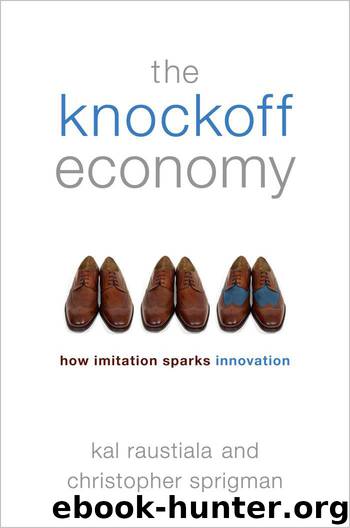The Knockoff Economy:How Imitation Sparks Innovation by Kal Raustiala & Christopher Sprigman

Author:Kal Raustiala & Christopher Sprigman
Language: eng
Format: mobi
Publisher: Oxford University Press
Published: 2012-08-01T14:00:00+00:00
Though fonts are clearly functional in this narrow sense, they may still be protectable by copyright if their aesthetic appeal is “separable” in some way from their utilitarian purpose—much like the jewelry designs we discussed in Chapter 1. But given that fonts, to perform their function, must be legible, the utility of fonts is pretty much unavoidable. When Congress passed the current copyright law, the accompanying report from the House of Representatives recognized this basic fact, stating that the relevant committee “does not regard the design of a font… to be a copyrightable ‘pictorial, graphic, or sculptural work’ within the meaning of this bill and the application of the [separability] dividing line.”15 In the years since, the United States Copyright Office has refused to register font designs. The few cases that have considered the issue have followed suit, ruling that fonts are uncopyrightable.16
So fonts are unprotected by copyright law.* Is there any law that does protect them against copying? In theory, a truly original font could be protected by a design patent, but for practical reasons patent has only marginal relevance. Patent’s novelty requirement would limit protection only to the most unusual fonts. But the most valuable have almost all been attractive but subtle variations on well-known designs. And a very unusual font would most likely be very hard to read.
Trademark law has even less relevance.17 While the names of fonts can be trademarked, fonts themselves cannot. Few consumers can even identify a single font by name, much less associate one with a particular producer. The absence of any consumer association between a font and its producer—what is known as “secondary meaning” or “acquired distinctiveness”—essentially eliminates the possibility of using trademark to protect fonts from copyists.
Font Technology and the Ease of Copying
For hundreds of years the inapplicability of copyright law to fonts didn’t really matter, because the technology of printing made fonts very hard to copy. Originally, type was produced in the form of wood blocks and then metal letter shapes. And from the invention of movable type in the 15th century until the early 19th century, the effort involved in designing a font was only a small fraction of the total effort involved in producing print-ready type. Fashioning the metal letterforms would take a punchcutter—a lost art that combined sculpture, metallurgy, and smithery—nearly 800 hours of full-time work.18 Under these conditions, plagiarizing made little sense, because the work necessary to reproduce the print-ready type meant that copyists and originators faced roughly equivalent costs in producing the finished product.
Download
This site does not store any files on its server. We only index and link to content provided by other sites. Please contact the content providers to delete copyright contents if any and email us, we'll remove relevant links or contents immediately.
You Don't Own Me by Orly Lobel(1345)
Intellectual Property Strategy by John Palfrey(1298)
Hello, My Name is Awesome by Alexandra Watkins(1265)
Without Copyrights by Spoo Robert(1166)
Profit From Your Idea: How to Make Smart Licensing Deals by Attorney Richard Stim(1143)
Democracy of Sound by Alex Sayf Cummings(1135)
A Triumph of Genius: Edwin Land, Polaroid, and the Kodak Patent War by Ronald K. Fierstein(1100)
The Trademark Guide by Lee Wilson(1093)
World War 3.0 by Ken Auletta(1071)
The Copywriter's Handbook by Robert W. Bly(1053)
Kafka's Last Trial by Benjamin Balint(1049)
Data Protection: A Practical Guide to UK and EU Law by Carey Peter(1047)
BVR's Guide to Intellectual Property Valuation by Michael Pellegrino(997)
Mass Media Law by Pember Don & Pember Don(983)
Patent It Yourself: Your Step-by-Step Guide to Filing at the U.S. Patent Office by Pressman David Attorney(976)
What They'll Never Tell You About the Music Business by Peter M. Thall(974)
The Tech Contracts Handbook: Software Licenses and Technology Services Agreements for Lawyers and Businesspeople by David Tollen(969)
Hello, My Name Is Awesome: How to Create Brand Names That Stick (BK Business) by Alexandra Watkins(966)
The New Censorship: Inside the Global Battle for Media Freedom by Joel Simon(934)
